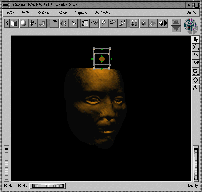

Figure 5 (left): Adding a light source
Figure 6 (right): Adding colour and texture.
Once in VRML format the reconstructions were amenable to enhancement using standard 3-D editing software. This allowed us to begin to experiment with point light sources, fixed viewpoints, skin-like textures, etc. (see Figures 5 to 8). Flexibility is also enhanced in VRML through the use of interpolators, which allow changes in shape and colour to be built in to the 3-D model. We used interpolators to experiment with three of the major 'unknowns' of facial reconstruction: obesity, ageing and ethnic affiliation.


Figure 5 (left): Adding a light source
Figure 6 (right): Adding colour and texture.
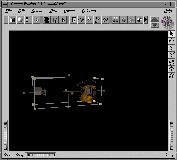
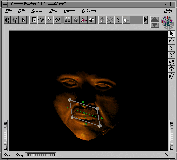
Figure 7 (left): Adding viewpoints
Figure 8 (right): Adding a moustache
Prototype models were developed using scanned plastic reconstructions as standards for the extreme values of the ranges of obesity versus emaciated, young adult versus elderly adult and 'White' versus 'Black'. Using this approach we first developed an interpolation model which 'morphs' between the 'emaciated' and 'obese' values of the published tissue depth datasets. A range of possible outcomes representing the potential range of obesity are represented in a 3-D model (Figure 9).
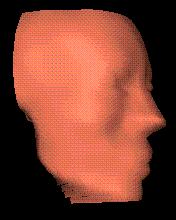
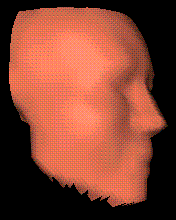

Figure 9 (a-c): Interpolating between 'emaciated' and 'obese' facial reconstructions.
Click on the images to view 'morphing' VRML file [236KB] or view using a slideshow.
A 'White' skin-like texture was applied and three fixed viewpoints which lead the viewer around the model were also included. Although tissue depth data are available which can be used to model obesity, no such measurements exist that can be used to model the ageing process in adults. Published data on ageing tend to be qualitative rather than quantitative and is largely descriptive. This information was used to model ageing of standard reconstructions taken from typical male and female skulls. Representations of the reconstructed face aged to approximately 30, 50 and 80 years were produced using non-quantitative data (Neave 1998). Scans of these plastic models were used to develop interpolation models of ageing in VRML. Simple linear interpolation models, morphing between the 30 and 80 year age standards, were developed first (Figures 10 and 11).

Figure 10: Linear interpolation between 'young' and 'old' facial reconstructions of a male. Click to view 'morphing' VRML file [1.53MB].

Figure 11: Linear interpolation between 'young' and 'old' facial reconstructions of a female. Click to view 'morphing' VRML file [1.68MB].
It is important to recall that the ageing process is non-linear, however. Ageing will progress at different rates for different people and will affect different parts of the face in different ways. In order to explore the potential for complex simulation of ageing, a non-linear interpolation model of ageing was developed, progressing from 30 to 80 years via a 50 year fixed standard (Figures 12 and 13).

Figure 12: Non-linear interpolation between 'young' and 'old' facial reconstructions of a male. Click to view 'morphing' VRML file [2.25MB] or view using a slideshow.

Figure 13: Non-linear interpolation between 'young' and 'old' facial reconstructions of a female. Click to view 'morphing' VRML file [2.38MB].
© Internet Archaeology
URL: http://intarch.ac.uk/journal/issue8/evison/enhance.html
Last updated: Mon Jun 26 2000